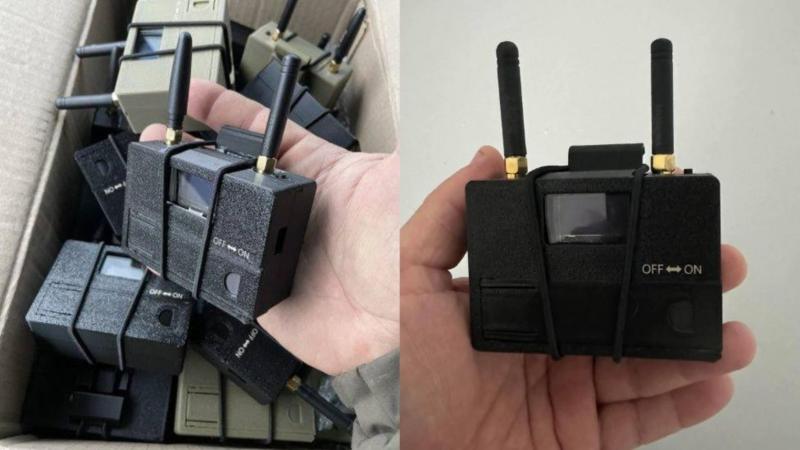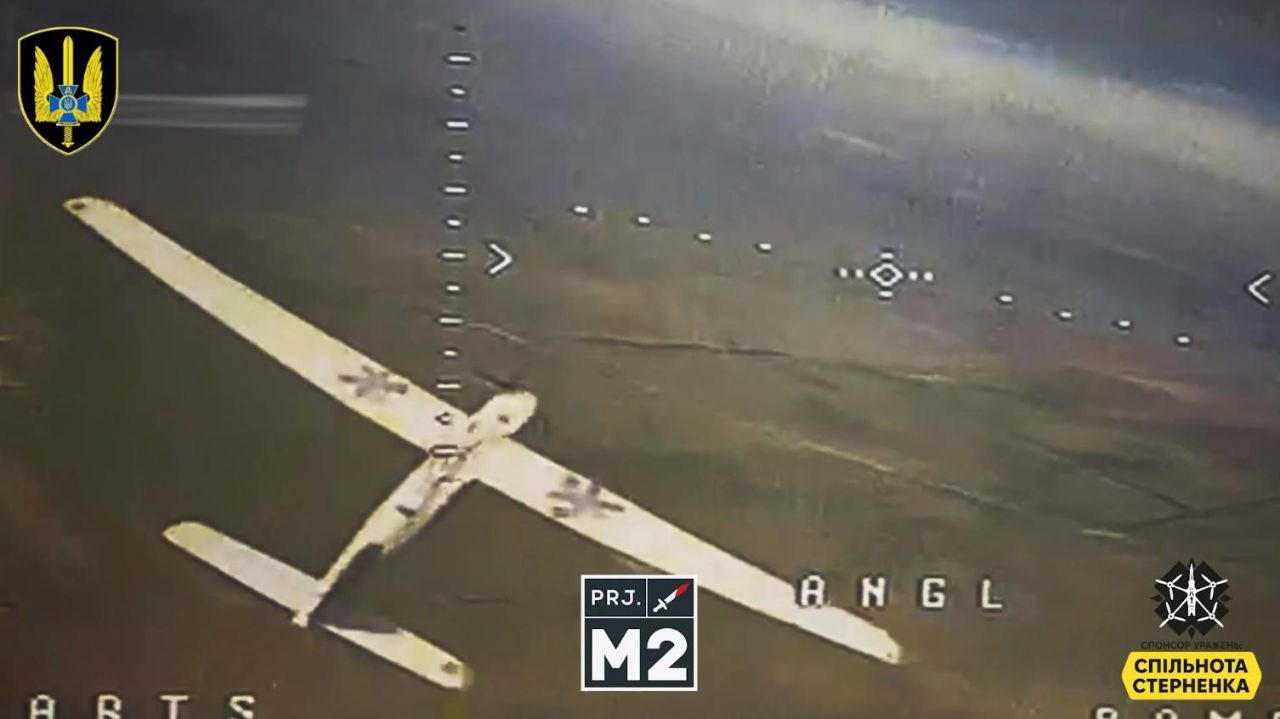In another indication of the ever-evolving role of drones in warfare, several videos of drone-on-drone battles have surfaced lately in the Russo-Ukrainian war.
UAVs have reshaped the battlefield in Ukraine, enabling the destruction of equipment worth millions of dollars with $500 drones, and defining offensive measures due to their reconnaissance function. Due to this, both Ukraine and Russia have raced to establish drone superiority, with Russia leading in terms of numbers.
Particularly troublesome for Ukraine was the presence of large, sophisticated reconnaissance UAVs that venture far from the frontline and guide missile strikes on Ukrainian military objects deep in Ukraine's rear, giving Russia a strategic advantage.
The latest videos suggest Ukraine may have found a cost-effective countermeasure to these reconnaissance drones amid a lack of air defense and electronic warfare systems.
In one video, an onboard camera filmed an unnamed First Person View (FPV) drone, which have become a replacement for artillery for Ukrainian soldiers amid a lack of ammunition, ramming into a ZALA reconnaissance drone. The outcome is unclear.
Drone-on-drone fights become increasingly more common in the Russo-Ukrainian war
Here an unknown FPV drone with a VTX 2.5W transmitter is seen striking a Russian ZALA 421-16E recon drone, crucial for Russian offensive operations
🎥 https://t.co/hghLWlrcZI pic.twitter.com/eaqsiDAodW— Euromaidan Press (@EuromaidanPress) June 1, 2024
Volunteer Serhiy Sternenko, who crowdfunds the production of FPV drones, also posted a video of drones being used as an anti-drone weapon. "M2 soldiers of the SBU's Special Operation Forces shot down a Russian reconnaissance UAV Orlan with your drone," he wrote in the post. The footage shows not only the "air battle" but also the eventual destruction of the enemy UAV on the ground.
Ukraine downs Russian reconnaissance ORLAN UAV in drone dogfight
The FPV drone strike by 🇺🇦soldiers from SBU's M2 SOF was made several weeks back thanks to crowdfunding from @sternenko community (🎥)
"Emergence of a full-fledged FPV-based anti-drone system is only a matter of… pic.twitter.com/drNe1AocBF
— Euromaidan Press (@EuromaidanPress) June 1, 2024
"The emergence of a full-fledged FPV-based anti-drone system is only a matter of time," Sternenko added.
Large Russian reconnaissance drones enable missile strikes far behind the frontline
Russia's ZALA, Orlan, and Supercam reconnaissance drones have recently become a significant problem for Ukraine. Acting in conjunction with Iskander or other missile launchers, they have enabled guided Russian strikes far in Ukraine's rear, including on such prized western equipment as HIMARS, Patriot, as well as Mi-8 helicopters, Mig-29 jets, and two Bureviy MLRS.
The long-range Russian UAVs have also enabled strikes on Ukrainian headquarters in the rear, flying freely above Ukrainian cities.
This situation has emerged because these UAVs are especially difficult to shoot down. They are virtually undetectable to the naked eye and hover at an altitude of 4-5 km, making them inaccessible for such MANPADS as Stingers, according to Ukraine's Air Force spox Illia Yevlash.
Yevlash said that Ukraine needed more mid-range air defense systems like NASAMS or the Soviet-era Buk to shoot down these reconnaissance drones that permanently hover above the frontline and search for targets that Russian missile systems can strike.
However, ammunition for air defense systems is scarce, and Russia has been producing these drones in great numbers.
Additionally, Russia has adapted their Orlan and Zala drones, enabling them to easily cross the frontline undeterred by electronic warfare (EW) systems, according to military analyst Serg Marco.
They now feature optical navigation systems and positioning systems that rely on two "beacons" or radio landmarks. These beacons provide the drone with its position in relation to coordinates, allowing it to calculate its location within a square kilometer based on the time it takes for the signal to reach the drone.
While not as precise as GPS, this method is sufficient for the drones to carry out their tasks.
The optical navigation system serves as a backup to the beacon-based positioning. The drones are equipped with maps of the terrain, and when the beacons are located, the onboard camera takes a screenshot, identifies reference points, and accurately determines the drone's position on the map.
These adaptations enable the Russian drones to cross the frontline in radio silence mode, making them less detectable and less vulnerable to Ukrainian EW measures.
They switch on the radio already deep in Ukraine's rear, where there is a lack of EW systems, and are able to easily conduct their reconnaissance mission before they are intercepted.
A Ukrainian military technology device called Tsukorok detects if Russian drones such as ZALA, Orlan, or the kamikaze Lancet drone are above a soldier, prompting them to disperse or get out. However, as of now, Ukraine lacks a solution for the penetration of long-range Russian reconnaissance drones into its rear.

This is why Ukraine's Ministry of Digital Transformation announced
a competition to create an interceptor drone that would automatically detect and attack Russian drones.
The idea of such drones has been circulated since the start of Russia's full-scale invasion, but so far, no accessible and effective solution has been found.
This makes the recent successes with Ukrainian FPV drones targeting the Russian Orlan and ZALA drones all the more significant. This is a cost-effective solution: the price of an FPV drone starts at around $500, while an Orlan costs $80,000-120,000, and the ZALA 421-16E shown being attacked is estimated to cost around $100,000-$200,000.
As well, using agile and versatile "flying bombs" FPV drones against Russian reconnaissance Orlans and ZALAs is a solution for insufficient air defense ammunition, much like attempts to use them to replace artillery amid a dire lack of shells.
One downside is that so far, FPV drone operation remains a task requiring extensive pilot training, which makes the success rate of the operations highly dependent on operator prowess. Although Ukraine has been developing solutions for FPV drones to lock on targets, learning to operate one still requires many weeks of learning.
Notably, in another incident, Ukraine downed an Orlan drone using a Soviet-era training Yak-52 propeller-driven aircraft in a WWI-style dogfight, with the second pilot using small arms to shoot down the Russian UAV.
Other drone-on-drone dogfights
Russia has been catching onto the potential for using drones to attack drones as well.
Several publicly shared videos show drone attacks on the Ukrainian Baba Yaga heavy-load octocopter.
One of them features a Russian Mavic "wedding" drone successfully dropping a bomb on the Baba Yaga, although some commentators mentioned that the subsequent detonation of both the Mavic's bomb and the Baba Yaga's payload on the targets above which it was flying meant that the Ukrainian mission succeeded.
🇷🇺🇺🇦Drone wars: A Russian drone sneaks up on a Ukrainian Baba Yaga drone and destroys it by dropping bombs from above. pic.twitter.com/jGydY2LXIS
— Aussie Cossack (@aussiecossack) May 31, 2024
Another video showed a Russian FPV drone attacking the Baba Yaga.
A Russian drone operator successfully intercepted and destroyed a Ukrainian Baba Yaga drone using a much smaller FPV drone. The Baba Yaga drone crashed but the Russian drone managed to stay in the air. pic.twitter.com/7hREU4LPyh
— OSINT Aggregator (@AggregateOsint) May 30, 2024
Related:
- Ukraine now has drones rescuing fallen drones from hazardous battlefields
- Expert: FPV drones can not replace artillery but are comparable with battalion mortar systems
- “They evolve”: Ukraine tests FPV drone featuring target detection, lock-on, and tracking system
- “They evolve”: Ukraine tests FPV drone featuring target detection, lock-on, and tracking system
- FPV drone tactics reshape conventional trench warfare in Russo-Ukrainian War

